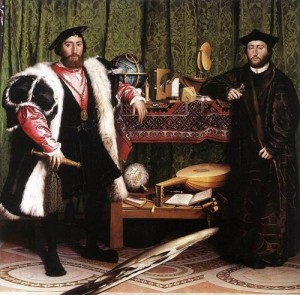 On 11th April 1533, Good Friday, King Henry VIII informed his Royal Council that Anne Boleyn was now his wife and that they must accord her with royal honours.
On 11th April 1533, Good Friday, King Henry VIII informed his Royal Council that Anne Boleyn was now his wife and that they must accord her with royal honours.
Two days earlier, Henry had sent a delegation of his councillors, led by the Duke of Norfolk, to Catherine of Aragon to inform her that her husband had remarried and that she was no longer queen and must call herself the Dowager Princess of Wales. Catherine did not comply, see 3 July 1533 – Catherine of Aragon Ordered to Recognise her New Title or Else!
11th April 1533, the date when Anne Boleyn was officially recognised as Queen, is recorded in the amazing painting by Hans Holbein the Younger, The Ambassadors, which portrays two ambassadors: Jean de Dinteville, maître d’hôtel to Francis I of France, and George de Selve, Bishop of Lavaur. Those who have analysed the painting have found the date marked on the celestial globe, the quadrant and the cylinder sundial. This has led to speculation that it was commissioned by Anne Boleyn, who is thought to have been Holbein’s patron at the time. The painting is rich with symbolism and is a real puzzle.
As I said in a previous article, clues to the painting’s link with Anne Boleyn include:-
- The painting was painted when Holbein was working on Mount Parnassus for Anne’s coronation.
- It was painted at the time when Anne was being recognised as Queen and preparing for her coronation.
- The date of the 11th April in the painting which coincides with Anne being recognised as Queen.
- The cosmati pavement whic Ives believes to mirror that of Westminster Abbey and “the precise spot where Anne Boleyn was anointed Queen”.1
- Jean de Dinteville’s links with Anne, their shared interest in evangelical reform, in the French ‘fashion’, and his role at her coronation. Ives ponders if Dinteville is actually depicted in his coronation outfit.
- The theme of the painting – Religious division but the hope of unity.
You can read more about Holbein’s “The Ambassadors” in the following series of articles:-
- Holbein’s The Ambassadors: A Renaissance Puzzle? – Part One: Context
- Holbein’s The Ambassadors: A Renaissance Puzzle? – Part Two: Symbols
- Holbein’s The Ambassadors: A Renaissance Puzzle? – Part Three: Jupiter and Change
Notes and Sources
- Ives, Eric (2004) The Life and Death of Anne Boleyn, p235
- North, John The Ambassador’s Secret: Holbein and the World of the Renaissance (2004)